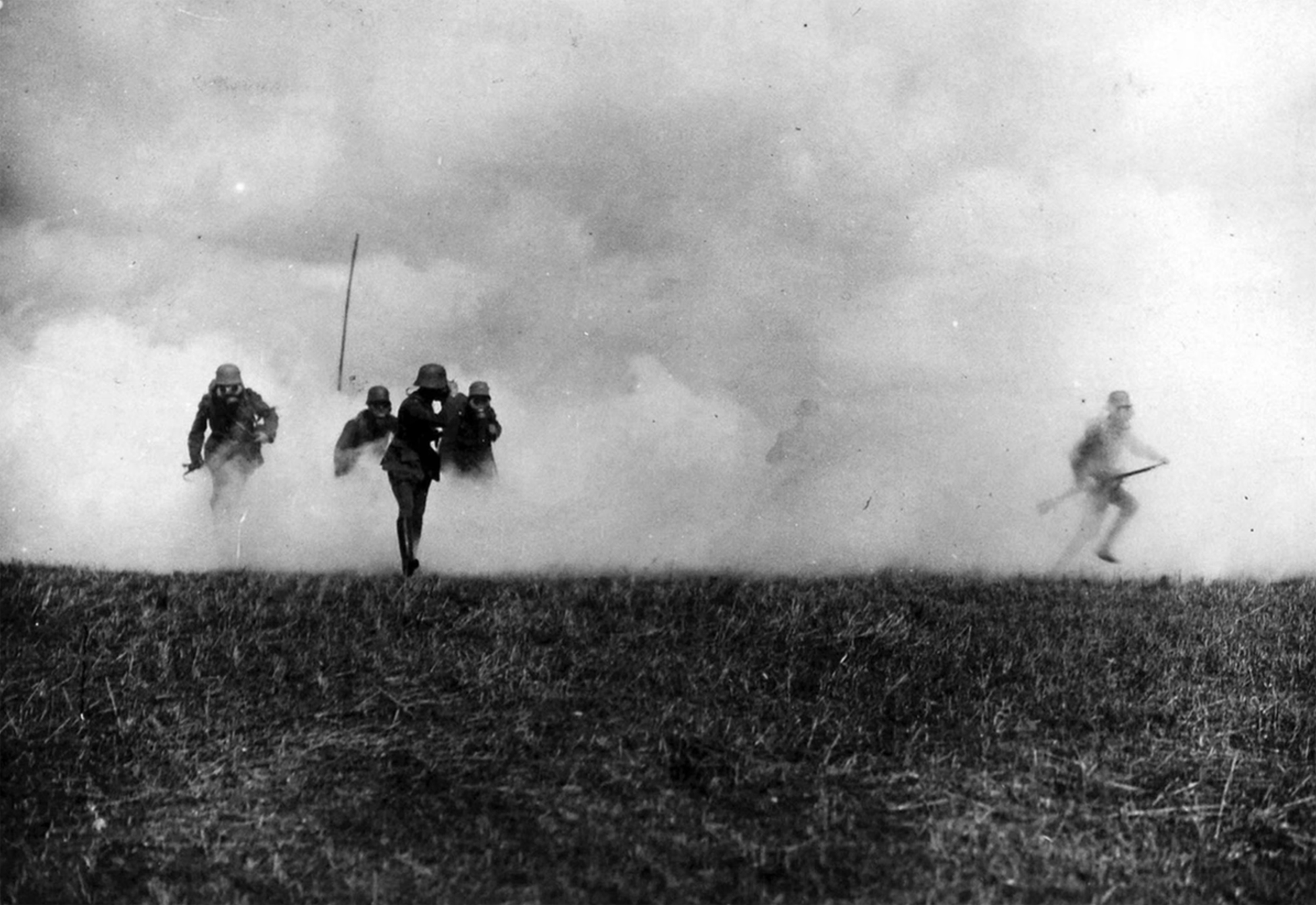

Nobody expected the first chlorine gas attack on April 22, 1915, to be quite so successful, including Fritz Haber, the weapon’s main advocate. The German scientist had proposed using chlorine gas on Allied troops, overseen its development as a weapon, and gone to the front lines himself to supervise placement of 5,730 gas cylinders along a 4-mile stretch of road near the trenches outside the Belgian town of Ypres.
And then Haber waited at the front lines for weeks, until the prevailing wind turned northwest. This capricious breeze was the weapon’s weakness: It needed to blow the chlorine gas from the cylinders buried on the German side, across no-man’s-land, and into the Allies’ trenches.
Haber had fought his own battle to just get the opportunity to try out the gas. Most of the German High Command was skeptical of poison gas as a weapon. “They saw the first chlorine attack as an experiment at best, and at worst, a kind of stunt,” says Andrew Ede, a science historian at the University of Alberta. Six months into the war, Haber had managed to convince only one commander on the Western Front to try out chlorine gas. After this chlorine attack killed more than 1,100 soldiers and injured many more, the lack of support changed dramatically.
The first large-scale use of chemical weapons that day in 1915 ignited a chemical arms race among the warring parties. By the end of World War I, scientists working for both sides had evaluated some 3,000 different chemicals for use as possible weapons; around 50 of these poisons were actually tried out on the battlefield, says Joseph Gal, a historian of chemistry at the University of Colorado, Denver.
The strategic power of chemical weapons in WWI was in the psychological terror they caused rather than the number of soldiers they killed: Poison gas was responsible for less than 1% of WWI’s fatalities and about 7% of its casualties. It might have done more damage, but both sides quickly developed protective gas masks that contained a wide variety of neutralizing agents.
Even though poison gas was not an efficient killing weapon on WWI battlefields, its adoption set a precedent for using chemicals to murder en masse. In the past century, poison gas has killed millions of civilians around the world: commuters on the Tokyo subway, anti-government demonstrators in Syria, and those incarcerated in Third Reich concentration camps, including some of Haber’s own family. Haber and his colleagues had as much control over their new weapon as they had control over the wind that blew chlorine across no-man’s-land on April 22, 1915.
By chance, the test site—what was to become known as Flanders Fields—also happened to be of strategic importance. The Allies held Ypres, located about 25 miles from the Atlantic coast and near a major supply port. If the Germans were to capture Ypres and block the Allies from accessing their supply port, that would have changed the “complexion” of the war, Ede adds.
In the first weeks of WWI, Germany had marched, seemingly unstoppable, through Belgium and France, occupying land quickly and easily. But the Allied defense ramped up. Within a few months, Germany’s momentum stalled, and both sides became mired in a muddy trench war that eventually stretched over 400 miles, from the North Sea to the French-Swiss border.
Sometimes, one army’s trench sat just a few yards from that of its enemy; sometimes the gap was as large as a mile. Both sides capitalized on the Industrial Revolution to mass-produce weapons that could kill at close range—grenades, machine guns, shell artillery, and more—but neither warring party could get the upper hand. Haber argued that chemical weapons could help end the impasse—and the war—in a matter of months. He was wrong. WWI raged on for another three and a half years after chlorine gas was first deployed near Ypres.
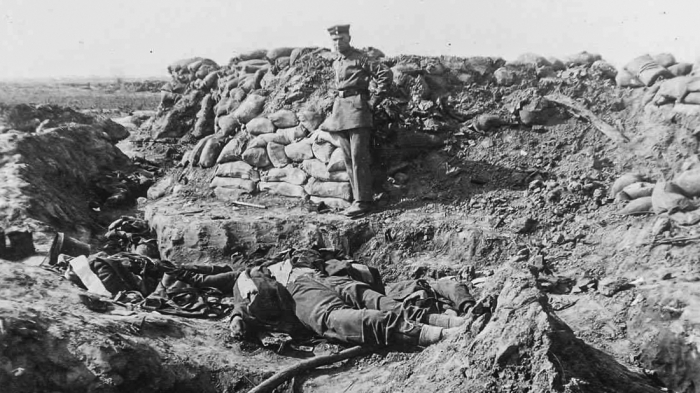
It had been a spectacularly sunny spring day. Then late that afternoon, around 5:30 p.m., German soldiers wearing rudimentary gas protection opened the valves on the chlorine cylinders. What emerged was a “queer greenish-yellow fog that seemed strangely out of place in the bright atmosphere of that clear April day,” wrote the Canadian soldier A. T. Hunter in the book Canada in the Great World War. The gas began wending its way toward two French regiments. To the left of the gas and the French troops, Canadian soldiers watched as the cloud “reached the parapet, paused, gathered itself like a wave and ponderously lapped over into the trenches,” Hunter wrote.
“Then passive curiosity turned to active torment—a burning sensation in the head, red-hot needles in the lungs, the throat seized as by a strangler,” Hunter wrote. “Many fell and died on the spot. The others, gasping, stumbling, with faces contorted, hands wildly gesticulating, and uttering hoarse cries of pain, fled madly through the villages and farms and through Ypres itself, carrying panic to the remnants of the civilian population and filling the roads with fugitives of both sexes and all ages.”
Haber and his scientific team had chosen chlorine gas for a few reasons. It was widely used in the German dye industry and thus widely available. The gas was also inexpensive to produce and did not divert any resources from the production of conventional weapons needed for the war, Colorado’s Gal says. From a practicality standpoint, chlorine gas was heavier than air and could sink into the trenches instead of disappearing up into the sky. Finally, the gas was a powerful irritant to eyes, noses, lungs, and throats. At high enough concentrations, exposed victims would die of asphyxiation.
Then passive curiosity turned to active torment – a burning sensation in the head, red-hot needles in the lungs, the throat seized as by a strangler.
A. T. HunterThe gas attack decimated two French divisions, creating a huge gap—5 miles wide and 2.5 miles across—in the Allied front lines, says Piet Chielens, a curator at In Flanders Fields Museum, in Ypres. The German Army then began to march into the emptied trenches. “What we saw was total death,” wrote a young German soldier named Willi Siebert in a letter to his son. “Nothing was alive. All of the animals had come out of their holes to die. … You could see where men had clawed at their faces, and throats, trying to get breath. Some had shot themselves.”
Despite the resulting devastation, the German Army couldn’t capitalize on its gas attack. Not expecting much to come of the experiment, the German High Command hadn’t assigned enough backup troops to take Ypres, says Mélanie Morin-Pelletier, a WWI historian at the Canadian War Museum, in Ottawa, Ontario. Then darkness began to fall, stalling the forward march of the German soldiers: They did not think it was safe to march into the night without backup, and the infantry had no gas protection. “The German soldiers were afraid of their own gas,” Morin-Pelletier says.
Meanwhile, to one side of the cloud, partially gassed Canadian troops “were either too stubborn or too unaware of the danger to get out of the way of the cloud following the attack,” Alberta’s Ede says. They and other Allied troops held their ground against the German Army until Allied reserves came to the rescue and forced the Germans backward.
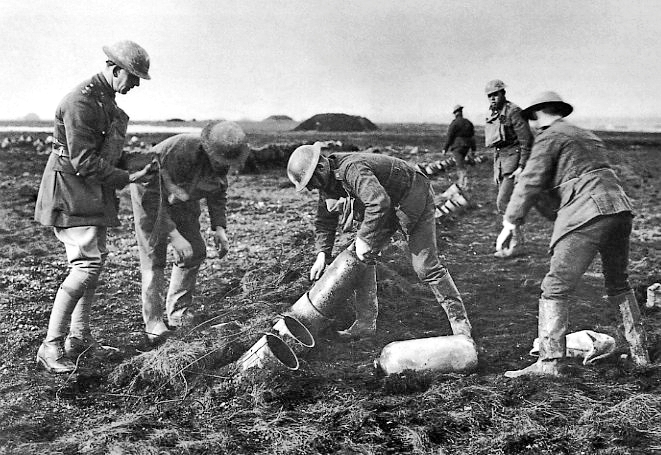
The chlorine attack may have come out of the blue for the soldiers on the ground, but the idea of chemical warfare was not new to military strategists. Poisonous weapons had been used on and off for millennia: They were deployed in ancient Greece; the Chinese used them against Genghis Khan; and indigenous people in South America had long used plant extracts as poison on their darts. Chemical and biological warfare was considered such an imminent threat that just seven years before the start of WWI, Germany, France, Britain, and many other Western nations had implemented an international treaty against poisonous weapons.
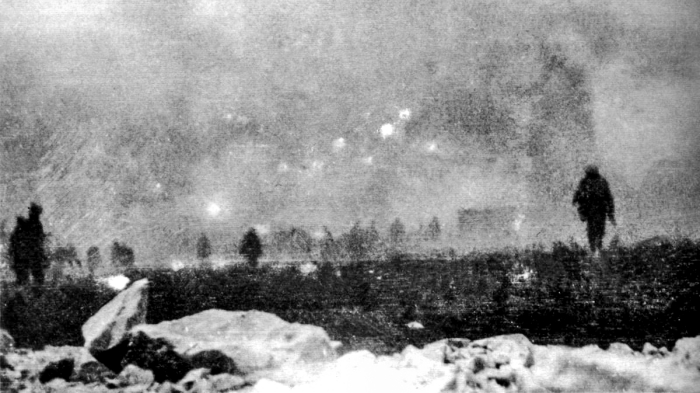
During the first weeks of the war, French troops broke that treaty when they deployed tear gas grenades on German soldiers, albeit with little consequence to troops. The German military also unleashed tear gas on both Russian and British troops early in the war. Both attempts failed because of technical difficulties: The poisons wouldn’t vaporize because of cold weather in one instance, and they were incinerated by explosive charges in the other. Allied commanders then began receiving reports from German prisoners of war and other intelligence that a larger gas attack was being planned, Morin-Pelletier says, but “they had no idea how to prepare.”
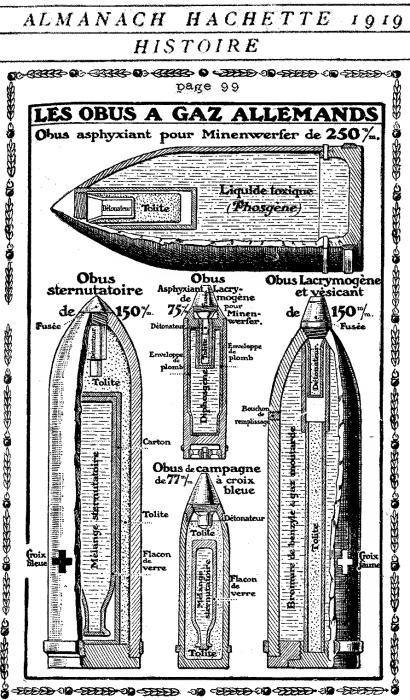
Although the idea of using chemical weapons had precedent, the chlorine gas attack at Ypres was a watershed moment; it was the first to successfully deploy chemical weapons on a massive scale. In doing so, “the Germans also handed the Allies a propaganda coup,” writes Edward M. Spiers in the book A History of Chemical and Biological Weapons. As one German officer named Rudolf Binding wrote after the first chlorine gas attack at Ypres, “I am not pleased with the idea of poisoning men. Of course, the entire world will rage about it at first and then imitate us.”
Within months, the British retaliated with chlorine gas at the Battle of Loos, in France. As news spread about the gas attacks, Allied chemists in Europe and North America had mobilized to help establish chemical weapons research programs, such as the U.K.’s Porton Down research center and what would become the U.S.’s Chemical Warfare Service. Although Germany “seized the initiative repeatedly in the gas war,” Spiers notes, by introducing the most prevalently used chemical weapons in WWI—namely chlorine, phosgene, and mustard gas—the Allies were often quick to catch up.
“It’s impressive how quickly the Allies figured out what the new poisons were, typically in a matter of weeks, sometimes even days,”Gal says. After all, he says, this was 1915, well before the introduction of top-notch analytical equipment.
The rapid Allied response can be attributed to a combination of things, Ede explains. At the time, Germany was leading the world in chemical research. As a result, many international chemists had spent a sabbatical or part of their training in the country. Because they’d been there, British, American, and French chemists “knew the chemicals used in the German chemical industry, and so they knew the chemicals likely to be stockpiled and on hand and thus available to weaponize,” Ede says. Furthermore, “at the time, there were only a handful of journals and everybody read them.”
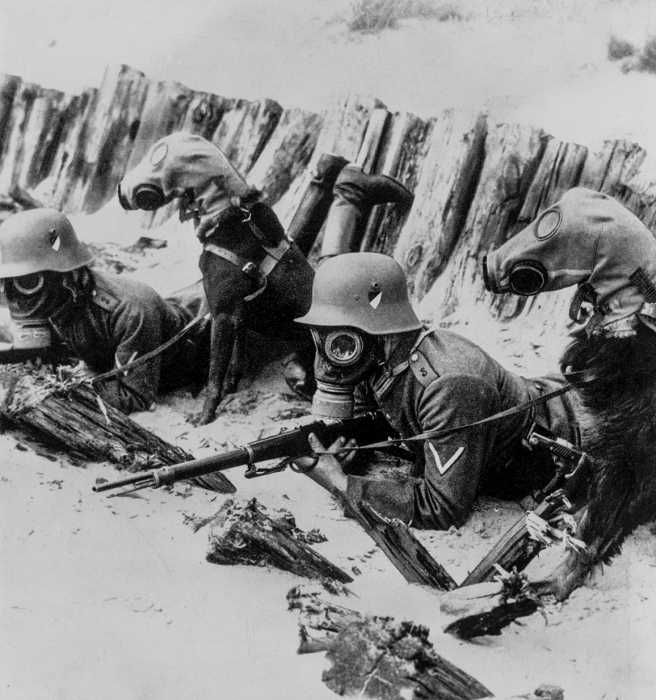
On the evening of that initial attack, one of the first frontline workers to realize the gas was chlorine was Lt. Col. George Nasmith, a sanitation expert from Toronto, Morin-Pelletier says. The 4-foot-6-inch man was too short to enlist as a soldier, but he convinced the Canadian Army to let him set up a small lab on the front lines to test soldiers’ drinking water. He spread the word that the poison gas was chlorine the evening of the attack, Morin-Pelletier says, as did a field ambulance doctor, Capt. Francis Scrimger. He told his staff to urinate on their handkerchiefs and use them as a face cover when they went into affected areas to rescue the wounded, she adds. Scrimger knew that the ammonia in urine, a base, could help neutralize chlorine gas, which transformed into a strong acid in body tissue.
“Soldiers were also told to dip handkerchiefs and rags in water,” which they would then place over their faces during gas attacks, explains Michael Freemantle, author of The Chemists’ War: 1914–1918 and Gas! Gas! Quick, Boys! How Chemistry Changed the First World War. Chlorine gas dissolves in water, he says, so the wet cloth helped pull the highly aggressive gas out of the air before soldiers breathed it in. These makeshift defenses helped defuse the new weapon—a necessary step because the German Army would deploy chlorine five times more on the battlefield near Ypres in the weeks after the first gassing.
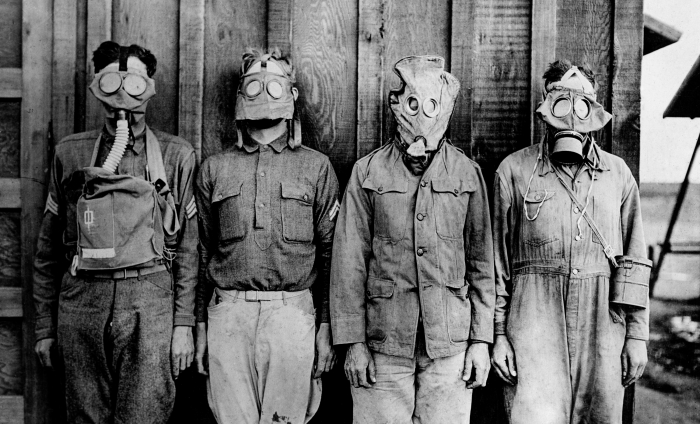
A variety of gas masks were soon devised and divvied out among Allied troops. Early gas masks, such as the Black Veil Respirator, reminiscent of a bandit’s mask, were rudimentary. Full-body, canvas cloaks with clear plastic viewing windows might have doubled as military-issue ghost costumes.
But eventually, more sophisticated respirators were invented. These hoods, often made from canvas or rubber, had plastic viewing windows and featured tubing that connected to a canister, which filtered the incoming air. The filter in the canister was of key importance, Freemantle says. As new gases were deployed on the battlefield, the filters had to evolve to deactivate all manner of poisons.
Gas mask filters had three important components. The first was activated charcoal, which features a highly porous structure that allowed air to pass yet also trapped larger poison gas molecules such as phosgene. The filters also contained acid-neutralizing agents, namely strong bases such as sodium hydroxide and calcium hydroxide. And finally, the masks contained oxidizing agents, such as potassium or sodium permanganate, which indiscriminately attacked and destroyed many poisons.
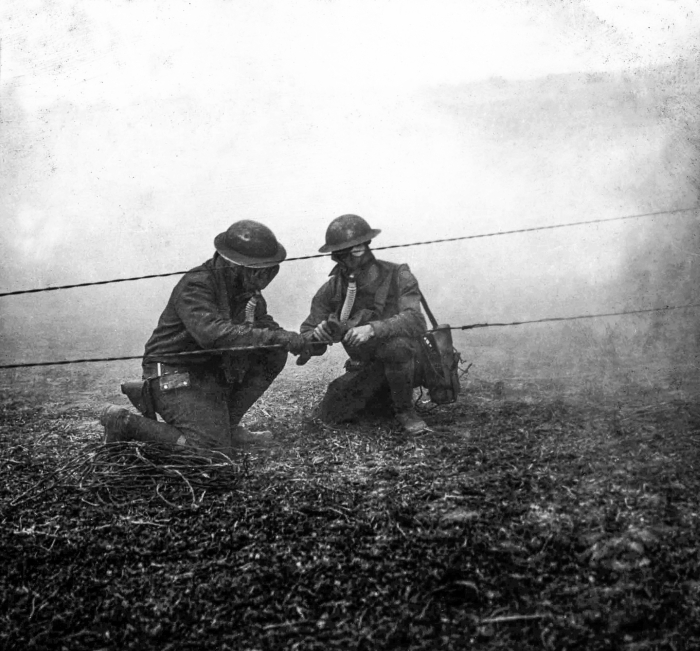
Within a year of the first gas attack, the Allies had gas masks that were as protective as those worn by German soldiers, Freemantle says. A major challenge on both sides was ensuring soldiers actually kept their gas masks on. “I don’t know if you’ve tried putting a gas mask on, but it is a very claustrophobic thing to do,” says Chielens, curator at In Flanders Fields Museum. “You feel like you’re suffocating anyway.” Military strategists knew that soldiers didn’t like wearing the heavy, hot, and uncomfortable masks, and they sought a way to provide a reason to take them off. They hit on the idea of arsenic-containing compounds that could penetrate the filters. “These were vomiting and sneezing agents,” Gal says. “The idea was to first fire these agents so that the soldiers would start vomiting. The first thing the soldiers would do was take off the gas mask. Then they would fire the real poison.” Although this plan was widely proposed, there’s not a lot of evidence that it worked well, Freemantle says. That’s because the chemicals didn’t always penetrate the filters, or the timing between poisons didn’t work out. The soldiers might also have simply stayed the course and kept their masks on.
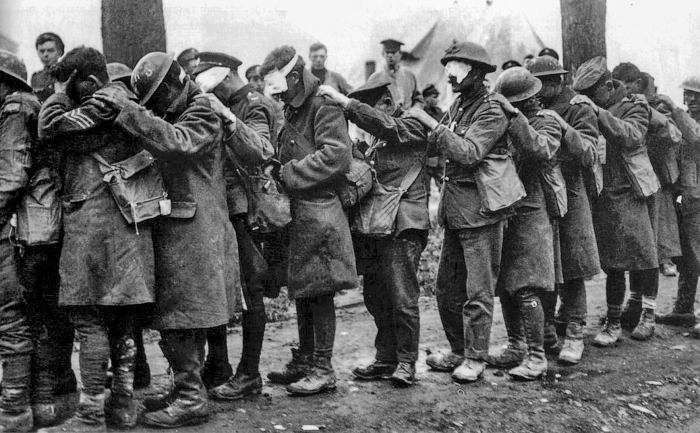
Eventually, both of the warring parties in WWI realized that deploying poison gas from cylinders was an unreliable strategy. “The wind was too difficult to predict,” Gal says. As a result, an overwhelming majority of chemical weapons used during the war were deployed in some form of artillery shell.
But getting these poisons into the shells posed some major problems, from the danger to factory workers to the technical challenges of transporting the weapons to the front lines without leakage, Gal says. Chemical weapons containing halogens, for instance, attacked the iron-containing shells of the steel artillery. To address this issue, workers would line the shell containers with lead, ceramic, or glass to prevent corrosion, Gal explains. Historians estimate that between 35 million and 66 million shells filled with chemicals were fired altogether, Gal says. “That’s a lot of poisonous projectiles.”
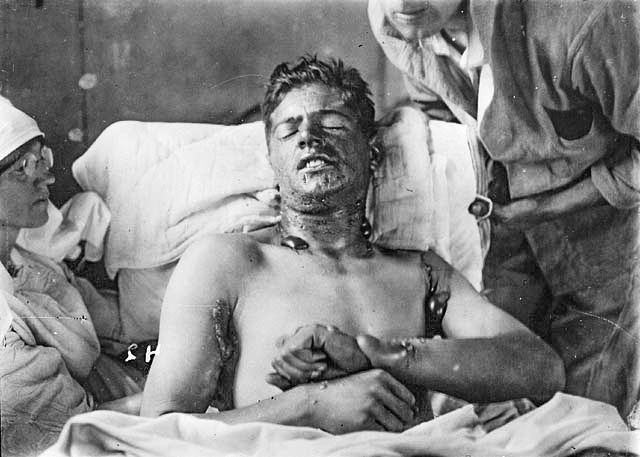
As gas mask technology improved, both sides got better at surviving onslaughts of poison-filled artillery shells, and once again the two sides hit a stalemate. That is, until the summer of 1917, when Germany introduced mustard gas. Within a year, the Allies were also deploying the poison. Soon known as the “king of the battle gases,” mustard gas is actually an oily liquid that can pass through leather, rubber, and most textiles. This liquid produces a toxic vapor that goes beyond hurting the eyes, nose, throat, and lungs, which are the standard gas target areas that can be protected with a mask. Mustard gas also attacks the skin. And it has a delayed reaction.
“The effects did not become apparent for up to 12 hours,” wrote John Ellis in Eye-Deep in Hell: Trench Warfare in World War I. “But then it began to rot the body, within and without. The skin blistered, the eyes became extremely painful and nausea and vomiting began. Worse, the gas attacked the bronchial tubes, stripping off the mucous membrane. The pain was almost beyond endurance and in most cases [victims] had to be strapped to their beds.”
Mustard gas caused the lion’s share of chemical weapons casualties in WWI. Victims were often temporarily and sometimes permanently blinded, and they took weeks, sometimes months, to recover, bogging down frontline medical facilities. When the poison killed, “death took up to four or five weeks,” Ellis notes.
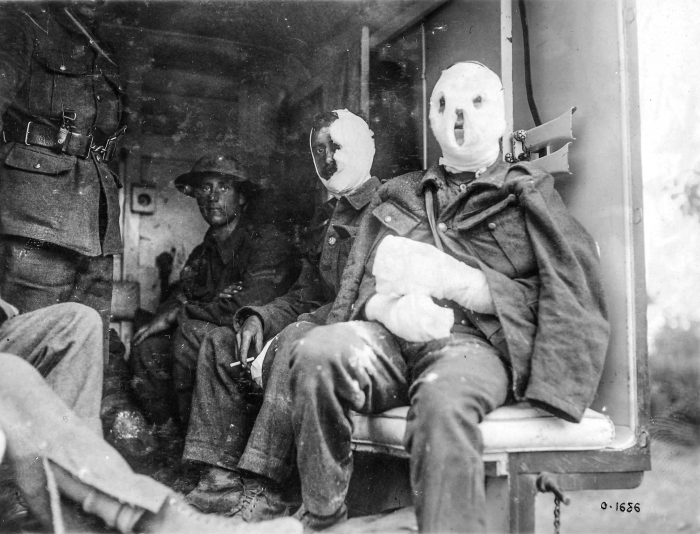
Mustard gas was also persistent for weeks in the environment. Troops could be marching through contaminated areas, unaware that they were being exposed. After returning to their trenches or barracks, they could then contaminate other soldiers many hours before their own blistering and blindness began.
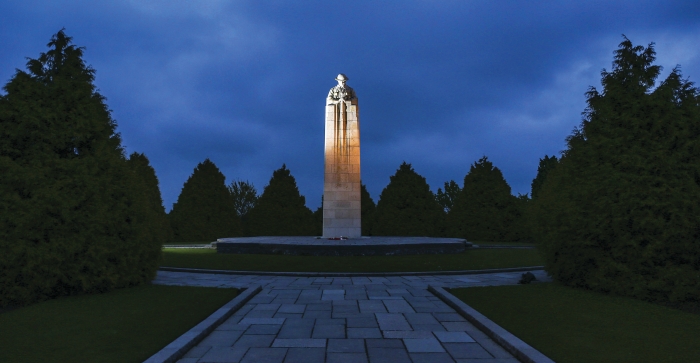
The Brooding Soldier memorial commemorates the Second Battle of Ypres, which included the first gas attack of WWI.
When armistice finally occurred on Nov. 11, 1918—three and a half years after the first chlorine gas attack—125,000 tons of poison gas had been deployed by all warring parties, with little strategic benefit.
A vast majority of WWI historians argue that chemical weapons had no decisive effect on the outcome of the war. According to Haber’s son Ludwig, a historian, chemical weapons were an ineffective weapon and a waste of resources. For Germany’s military, poison gas “did not win them a battle, let alone give them a victory,” Ludwig wrote in The Poisonous Cloud: Chemical Warfare in the First World War.
Yet in the postwar aftermath, chemical weapons had some notable fans. Winston Churchill didn’t understand “this squeamishness about the use of gas.” He argued that gases could be used to inconvenience the enemy and spread terror, not necessarily to kill. According to author Freemantle, “In July 1944, when [Churchill] was Secretary of State for Defence, he wrote a memorandum to the War Office requesting that Germany be drenched with poison gas.”
Until his death in 1934, Haber also argued in favor of chemical weapons, contending that they were more ethical than conventional weapons. “Chemical warfare is certainly no more horrible than flying pieces of steel; on the other hand, the mortality from gas injuries is smaller,” Haber noted in 1919.
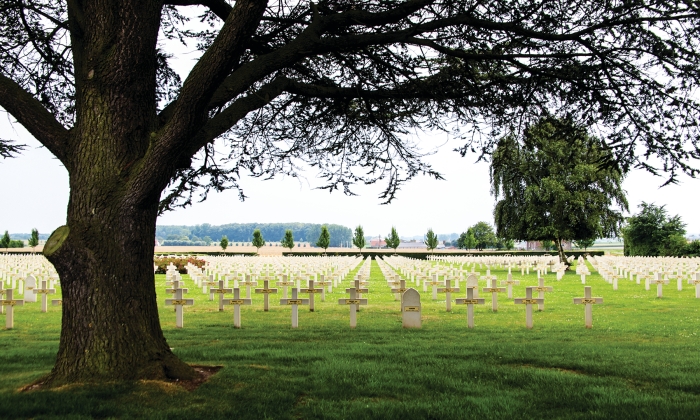
A WWI cemetery for French soldiers near Ypres, Belgium, includes some who died in the first gas attacks.
Haber was correct that machine guns, high explosives, and artillery shells led to far more casualties and deaths than chemical weapons: Poison gas caused less than 1% of total WWI fatalities and less than 2% of American war fatalities. “Strategically, poison gas wasn’t effective,” Chielens says. “But from the point of view of the men who had to work with it—be exposed to it—it was a terrible weapon.” Chielens should know: As a young boy in Belgium, he played in Flanders Fields and grew up listening to local veterans talk about the First World War. “The psychological terror on the ordinary soldier was immense,” Chielens says. “Will I be able to stand this?” and, “How much longer can I be able to hold out?” were common sentiments.
Postwar public perception of chemical warfare in the U.K., Germany, and the U.S. was negative. “People fear gas in a way they don’t fear conventional weapons. I don’t think it’s based on any rational analysis of battlefield statistics,” Ede says. “I think it’s just based on the idea of what it would personally be like to suffer through a gas attack. The public perception is that it is evil and unsportsmanlike.”
Many in the military also thought chemical weapons were unsportsmanlike. In the U.S., Peyton March, the Army’s chief of staff in 1918, tried to disband the U.S.’s Chemical Warfare Service (CWS) on humanitarian grounds but failed after heavy lobbying from many in the chemical enterprise, Ede says.
For the chemists, “CWS offered the biggest, best-funded, and best-staffed laboratories in North America,” Ede notes. “In the short time CWS had existed, it had spent more than $83 million,” or $1.1 billion in U.S. dollars today, he notes. “And [it] had the capability to produce 675 tons of offensive chemical agents a week.” It was a Manhattan Project before the Manhattan Project, he says.
The Journal of Industrial & Engineering Chemistry, published by the American Chemical Society (which also publishes C&EN), was the mouthpiece of the postwar chemical weapons lobby, Ede says. The journal’s editor, Charles H. Herty, argued often that “chemical warfare has come to stay.”
Even a decade after the end of WWI, the pro-chemical-weapons lobby was still going strong. One chemist, Harry Holmes, argued in both the New York Times and Scientific American that the public would be less afraid of chemical warfare if it could be demonstrated scientifically that defense against attack was an easy matter. “He suggested that tear gas be dropped on a small [American] city to test the effectiveness of gas defense training,” Ede says. “Holmes found no volunteers to undertake his experiment, and such suggestions did little to reassure the public as to the humanity of the supporters of the Chemical Warfare Service.”
In the end, many Allied countries continued their chemical weapons research, such as in the U.K., at the Porton Down research station, and in the U.S., eventually under the umbrella of the Army’s Chemical Corps. Meanwhile, in Germany, Haber continued researching chemical weapons through the 1920s as well, although he did it secretly and in direct contravention of the terms of Germany’s surrender.
“Haber recognized after the war that you couldn’t think of the next war without being concerned about chemical weapons,” Ede says. Here, he was absolutely correct. Today, even though chemical weapons disarmament treaties such as the Geneva Protocol and the Chemical Weapons Convention have been drafted and signed, national armies and terrorists alike have continued to deploy poisonous compounds on soldiers and civilians.
If Haber realized he had opened Pandora’s box in 1915 and suffered any regret about it, he did not say so: He maintained that chemical warfare was an ethical wartime weapon until his death. Certainly, he knew that trying to undo the precedent of chemical warfare would be as difficult as stuffing chlorine gas back into a cylinder buried in the mud in Flanders Fields.
Listen to Jörg Emes narrate German soldier Willi Siebert’s letter to his son about the first gas attack.
Finally, we decided to release the gas. The weatherman was right. It was a beautiful day, the sun was shining. Where there was grass, it was blazing green. We should have been going on a picnic, not doing what we were going to do. …
We sent the [German] infantry back and opened the [gas] valves with the strings. About supper time, the gas started toward the French; everything was stone quiet. We all wondered what was going to happen.
As this great cloud of green grey gas was forming in front of us, we suddenly heard the French yelling. In less than a minute they started with the most rifle and machine gun fire that I had ever heard. Every field artillery gun, every machine gun, every rifle that the French had, must have been firing. I had never heard such a noise.
The hail of bullets going over our heads was unbelievable, but it was not stopping the gas. The wind kept moving the gas towards the French lines. We heard the cows bawling, and the horses screaming. The French kept on shooting.
They couldn’t possibly see what they were shooting at. In about 15 minutes the gun fire started to quit. After a half hour, only occasional shots. Then everything was quiet again. In a while it had cleared and we walked past the empty gas bottles.
What we saw was total death. Nothing was alive.
All of the animals had come out of their holes to die. Dead rabbits, moles, and rats and mice were everywhere. The smell of the gas was still in the air. It hung on the few bushes which were left.
When we got to the French lines the trenches were empty but in a half mile the bodies of French soldiers were everywhere. It was unbelievable. Then we saw there were some English. You could see where men had clawed at their faces, and throats, trying to get breath.
Some had shot themselves. The horses, still in the stables, cows, chickens, everything, all were dead.
Everything, even the insects were dead.
— Willi Siebert, a German soldier who witnessed the first chlorine gas attack, wrote this account of the event for his son in English.
Credit: Josh Devins/C&ENListen to Josh Devins narrate the diary entry of Canadian soldier A. T. Hunter about the first use of chlorine gas as a weapon in WWI.
The French troops “saw none of this installation of premeditated murder. Looking across to the German trenches at about five in the afternoon, they saw a series of sharp puffs of white smoke and then trundling along with the wind came the queer greenish-yellow fog that seemed strangely out of place in the bright atmosphere of that clear April day. It reached the parapet, paused, gathered itself like a wave and ponderously lapped over into the trenches.
“Then passive curiosity turned to active torment – a burning sensation in the head, red-hot needles in the lungs, the throat seized as by a strangler. Many fell and died on the spot. The others, gasping, stumbling with faces contorted, hands wildly gesticulating, and uttering hoarse cries of pain, fled madly through the villages and farms and through Ypres itself, carrying panic to the remnants of the civilian population and filling the roads with fugitives of both sexes and all ages.”
— A.T. Hunter, Canadian Soldier, who witnessed the first chlorine gas attack. Excerpt from Canada in the Great World War (1919), The Second Battle of Ypres.